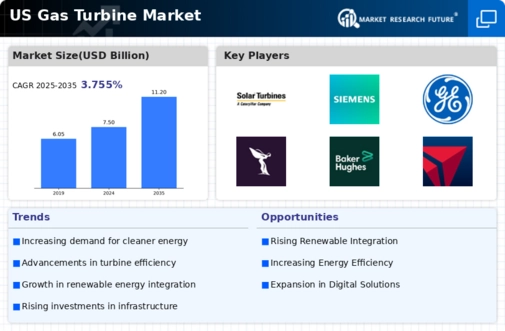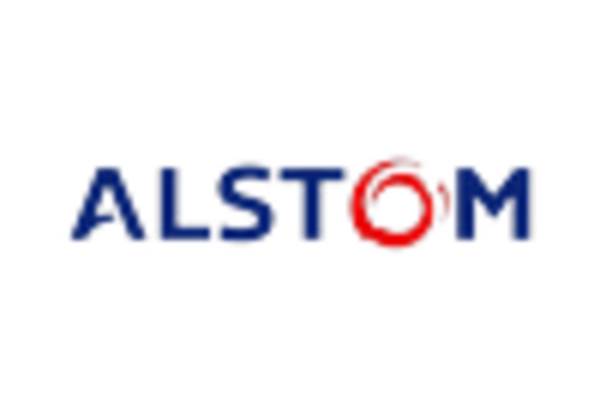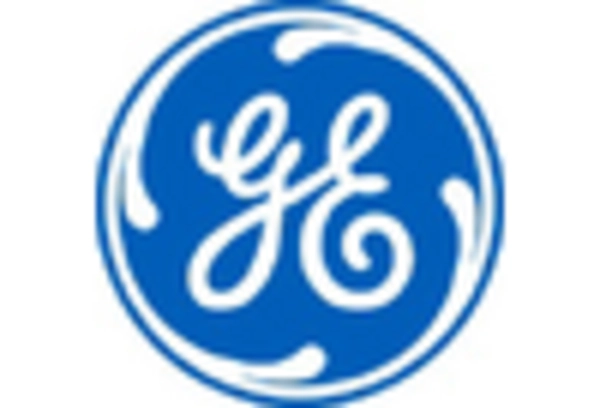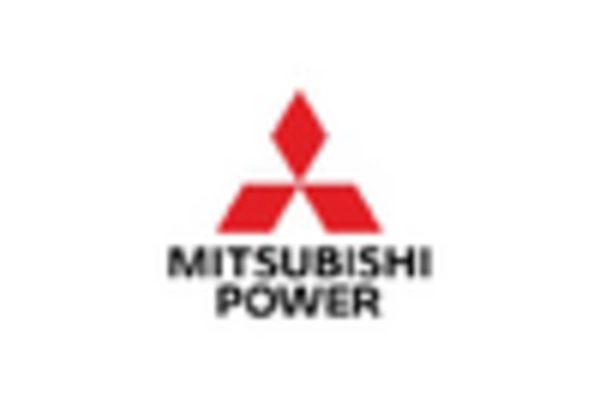The gas turbine market is currently characterized by a dynamic competitive landscape, driven by the increasing demand for efficient and sustainable energy solutions. Key players such as General Electric (US), Siemens (DE), and Mitsubishi Power (JP) are at the forefront, each adopting distinct strategies to enhance their market positioning. General Electric (US) focuses on innovation in turbine technology, particularly in the realm of digital solutions and predictive maintenance, which enhances operational efficiency. Siemens (DE) emphasizes sustainability, investing heavily in green hydrogen technologies to complement its gas turbine offerings. Meanwhile, Mitsubishi Power (JP) is expanding its footprint in the North American market through strategic partnerships and localized manufacturing, aiming to cater to the growing demand for cleaner energy solutions. Collectively, these strategies indicate a shift towards a more integrated and sustainable approach within the competitive environment.
In terms of business tactics, companies are increasingly localizing manufacturing and optimizing supply chains to enhance responsiveness and reduce costs. The market structure appears moderately fragmented, with several key players exerting influence over various segments. This fragmentation allows for a diverse range of offerings, yet the collective strength of major companies like General Electric (US) and Siemens (DE) shapes the competitive dynamics significantly, as they leverage their technological advancements and market reach to maintain leadership positions.
In October 2025, General Electric (US) announced a partnership with a leading renewable energy firm to develop hybrid gas turbine systems that integrate renewable energy sources. This strategic move is likely to position General Electric (US) as a pioneer in the transition towards more sustainable energy solutions, aligning with global trends towards decarbonization. The collaboration not only enhances their product portfolio but also strengthens their commitment to reducing carbon emissions in power generation.
In September 2025, Siemens (DE) unveiled its latest gas turbine model, which boasts a 65% efficiency rate and is designed to operate on a blend of natural gas and hydrogen. This innovation underscores Siemens' commitment to sustainability and positions the company to capture a growing segment of the market that prioritizes low-emission technologies. The introduction of this model is expected to bolster Siemens' competitive edge, particularly in regions where regulatory frameworks are increasingly favoring cleaner energy solutions.
In August 2025, Mitsubishi Power (JP) expanded its manufacturing capabilities in the US by opening a new facility dedicated to the production of advanced gas turbines. This expansion is indicative of Mitsubishi Power's strategy to localize production and enhance supply chain efficiency, thereby reducing lead times and costs. The facility is expected to play a crucial role in meeting the rising demand for gas turbines in North America, further solidifying Mitsubishi's market presence.
As of November 2025, the competitive trends in the gas turbine market are increasingly defined by digitalization, sustainability, and the integration of artificial intelligence. Strategic alliances are becoming more prevalent, as companies recognize the need to collaborate in order to innovate and meet evolving customer demands. The competitive landscape is shifting from traditional price-based competition towards a focus on technological advancement, reliability, and sustainability. This evolution suggests that future differentiation will hinge on the ability to deliver innovative solutions that not only meet performance standards but also align with global sustainability goals.

















Leave a Comment